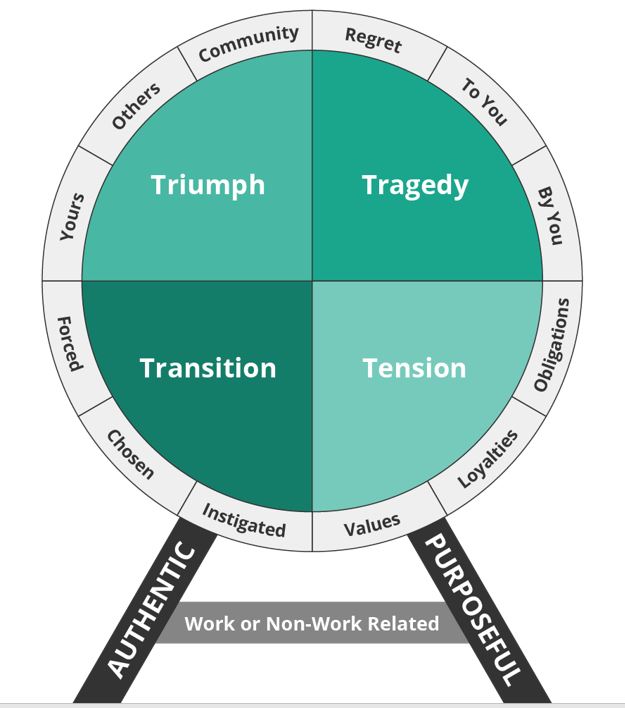
Imagine speaking to a room full of business professionals. With bated breath, they sit upright, awaiting your presentation.
What would happen if your first few slides are filled with graphs and charts of your brand’s performance? Or slick photos of your latest award winning products?
Chances are that your audience will tune out. They may start to twiddle with their mobile phones. Or glance at one another, rolling their eyes.
Some may even yawn, and catch forty winks!
If a live audience can be so easily bored, what more your professional connections on LinkedIn, Facebook, and Twitter? Wouldn’t their responses be even less enthusiastic?
Thankfully, there is a way to capture the attention of your Business-to-Business (B2B) social media audiences—through the art of business storytelling.
Four Types of Business Stories
In her book Stories for Work: the essential guide to business storytelling, author Gabrielle Dolan provides a fabulous framework that we can use for storytelling in different professional and B2B contexts.
Called The Story Wheel, it revolves around four main types of stories:
- Triumph: Moments where you’ve succeeded over difficult circumstances, including helping others or members of your community
- Tragedy: Negative circumstances that you regret. These may be caused by you or may have happened to you.
- Tension: Compromising situations that affected your values, loyalties or obligations
- Transition: Milestones of significant changes in your life, which could be spurred by you or compelled upon you.
These story types should be supported by two principles:
- Authenticity: They must be true and not fabricated. In other words, relate an incident that really happened to you, or that you’ve heard.
- Purpose: They should be linked to your work, business, or product in some way or other. This will help you to seal the deal.
You can see how the story wheel looks in the diagram below.

Original courtesy of Gabrielle Dolan
Let us look at each story type in more detail below.
#1 Stories of Triumph

Created by jcomp – www.freepik.com
Your sweet victories can be great fodder for storytelling. After all, we love to read, watch or listen to the successes of others.
Triumphant tales can be your own personal stories of achievement. Rather than boast about your accolades, focus on why the experience is important to you personally, and relate it to your audience with vulnerability and humility.
You can also consider stories where you helped others to win. They can be part of your team, or members of a wider community.
Examples of Triumph Stories
- Customer Successes: Relate how a client used your service to achieve significant improvements at work or in life
- Personal Testimonies: Narrate how you personally benefited from a winning formula in your business, and how it can benefit others
- Brand Milestones: Chronicle the process of growing your brand from strength and strength, and how many it has helped along the way
#2 Stories of Tragedy

Woman photo created by jcomp – www.freepik.com
Sometimes, tales of tragic circumstances may be more stirring than those of triumph. Especially if they lead to priceless life or business lessons.
These could be stories of regret or difficulty that you may have experienced. They can include both events which happened to you or which were caused by you.
Jack Ma’s rejection from 30 jobs (including KFC) and inability to get into Harvard despite applying for it 10 times is a well-known story of tragedy. Fortunately, the founder of Alibaba overcame his failures and became one of China’s most successful and richest man.
Examples of Tragedy Stories
- Rags-to-Riches: Showcase through storytelling how tragic circumstances can be overcome, and show them how
- “If Only” Stories: These are tales that demonstrate how much better your life could have been if you only applied what you knew now to an earlier self
- Mistakes Made (and How to Avoid): Chronicle a failure that happened to you or a company you know, and how you resolved them
#3 Stories of Tension

Image by Darby Browning from Pixabay
According to Dolan, stories of conflict can help to capture the attention of your audience. There are three types of tension which you could focus on here:
- Conflicting values: These are situations where you are torn between two competing beliefs, or where you are forced to choose an option that you do not believe in.
- Conflicting loyalties: Are there situations where you had to choose between your work and your family? Or between two individuals to decide who should be promoted?
- Conflicting obligations: Women especially may experience the torment between balancing multiple roles as a professional, a wife, a mother and a daughter.
Examples of Tension Stories
- From “Either… Or…” to “This… And That…”: Describe a situation where a protagonist have to choose between succeeding in her career or spending more time to nurture her children. Can your offer resolve that dilemma?
- How I Resolved My Conflict: These are stories where you describe how you manage to resolve a particularly polarising situation.
#4 Stories of Transition

House photo created by pressfoto – www.freepik.com
What are the major transitions in your life?
These may be work-related like getting your first promotion, or being fired, or changing jobs, or switching careers. Or they can be non work-related too, such as relocating to a different country, getting divorced (or married), buying your first home, or going back to school at a ripe old age.
Here, you can consider either transitions forced upon you, like being made to choose a course of study which you didn’t enjoy as a child because “it is better for your future career.”
Or it can be a transition that you have chosen or have instigated, eg taking a year off work, or deciding to adopt a child.
Examples of Transition Stories
- Career Changes: Chronicle an episode in your life where you experienced a significant change in your job, and what lessons you learned then.
- Parenting Stories: From first-time parenting encounters to insights from your conversations with your children, the world of parenting is full of anecdotal nuggets
- How One Thing Changed Everything: In this story type, your goal is to focus on just one thing which helped to turnaround your life or your work
How to Build Your Business Stories
Now that you’ve learned about the four story types, you now need to put your story together. In the book, Dolan recommends that we use Aristotle’s three-step story structure which has a beginning, middle, and end.
Let’s look at how this can be applied!
#1 The Beginning (aka The Hook)
Also known as your hook, the beginning of your story is critical. You need to engage your audience right away.
Consider starting with a specific time and place. Examples include:
- “When my promotion was denied in June 2012, I knew that I can no longer work there…”
- “19 May 2005 was the day when I disrupted my own career…”
- “He joined the company 4 years ago as a rookie, and got off to a bad start on his first day of work…”
- “The day the planes crashed into the twin towers in New York, my colleagues and I were drinking ourselves silly in a club in Orchard Road…”
You may also consider jumping straight into the action (aka In Media Res), by quoting from the most exciting part of your story:
- “Perched precariously on the 24th storey ledge, she was ready to jump and end it all…”
- “OMG! He shook my hand and signed my book!”
- “I am going to make you an offer that you cannot refuse,” said the HR Manager.
#2 The Middle
This is considered the “meat” of your story, and should contain all the pertaining details.
Often, the best stories have a strong plot—a storytelling structure which lays out the series of events in a captivating manner.
Here are some other tips from Dolan which you should consider:
- Relevant Details: Only include the parts of the story that are related to the plot, and omit all other details.
- Name Your Characters: Use your characters’ real names if you can—should you be unable to do so, just state the person’s age, designation and other pertinent details.
- Keep It Conversational: Avoid using business or technical jargon, and keep your language human, emotional and direct.
#3 The End
To end your story with impact, consider the three parts proposed by the book.
Build a Bridge
A bridging sentence helps to connect your story back to a business context. Use sentences such as the following:
- “What has my story got to do with you? Well, let’s look at…”
- “This incident is a good reminder that whatever we do is…”
- “Like my harrowing near-death experience, a good organisation must be able to…”
Link to Your Purpose
This is the final one or two liners that brings your story back to your purpose. It is way of closing your story loop, so to speak.
Here are some ways to do so:
- “Imagine how you can jump-start your career if you did what Sally did…”
- “You can also enjoy the benefits of upgrading your machine, just like my client Seng Huat…”
- “If you wish to also turnaround your personal brand like me, take the next step…”
Include a Pause
Obvious, you can’t really “pause” with a written story, but you can do with an audio podcast, or an online video.
Use this tiny slice of silence to let your message sink in.
Conclusion
As a content strategist and social media marketing professional, I often struggle to craft compelling yet digestible stories for my B2B audience.
Thanks to Gabrielle Dolan’s Stories for Work, we now have an easy-to-follow framework to craft our stories.
I hope that the above structures have been useful for you, and encourage you to get your own copy of the book. And if you need more ideas on how to storify your B2B business, read this other article.
Which business stories do you find more engaging and why?
